The Plague of The Mediocre Athlete
"No Glutes Equals No Results"
If you've read my articles and training manuals, you know I preach footwork and horsepower. Get light and smooth on your feet and learn to move optimally, then increase the force you're able to exert in your sports movements. The main difference between average athletes and good athletes is found in the functionality of the feet, as well as the strength, development, and function of the glute musculature. The glutes are mainly responsible for the horsepower factor and what I will talk about in this article.
Non-Existent Glutes
Too many people have non-existent glutes. From a strength perspective, if you were to consciously go in the weight room and do nothing but attack your glutes like a bodybuilder attacks his biceps, or a bench press specialist attacks the strength his triceps, you wouldn’t be that far off the mark. I don't believe it's possible for an athlete to have TOO much glute strength. There are some great athletes that are puny enough they look like they could be toppled by a slight gust of wind. These weak and stringy folk may at glance appear to shoot holes in the whole "You gotta be strong to be explosive argument", but 9 times out of 10 even these apparently feeble athletes will have very powerful glutes in relationship to their overall size and body musculature.
Due to their natural strength and the leverage advantage they have over your legs, the glutes should always be the primary muscles that drive lower body movement. Not only does this include more ballistic activities like running and jumping, but also walking.
There are 2 main problems that occur with regard to the glutes:
Inhibited glutes: In this situation the glutes are on permanent shutdown mode. For a variety of reasons, they don’t contract in your daily life when you walk, stand, get up off the pot, or when you move in sport. This situation has probably been overblown in the sports world, but does exist.
Overshadowed glutes: Here the glutes DO fire correctly, but are not as strong as other lower body muscles (like the quadriceps), thus the body will use other muscles to do what the glutes SHOULD be doing, resulting in inefficient performance and often some type of pain or injury over the long haul. Whenever you perform a movement such as a squat, lunge, deadlift, jump, sprint, or any exercise that involves several different muscle groups, the majority of work will tend to be done by the strongest of those muscle groups. Your natural body structure will also influence this to an extent. For example, if you have long arms and strong triceps you'll probably get little chest stimulation out of a bench press. If you have naturally big and strong biceps you may also have a hard time getting much lat stimulation out of pull-ups. Technique will also have a substantial impact on all of this, but one problem many athletes have is they naturally have proportionately more strength and natural muscle cells in muscles other than their glutes, like their thighs.
Look at the athleticism of athletes that tend to easily develop massive quadriceps. They tend not to be very impressive athletes.

Pretty - But (often) Slow and Groundbound
Many gifted athletes turned bodybuilders will tell you that squats make their butts big and they have a more difficult time getting much lower quadriceps development. That glute dominance is a good thing from an athletic perspective.
What happens sometimes is people who don't naturally have great glute activation patterns and don't have naturally good muscle balance (ie. Dont have glutes that are naturally stronger than thighs) get in the weightroom and do exercises that SHOULD be strengthening their glutes but they end up strengthening their thighs and their glutes get very little. When you throw them into an athletic environment the body will naturally use the strongest muscles to control movements, so now their quads and other muscles will want to do what the glutes should be doing.
Getting Strong In The Right Places
You need strength but you need it in the right places. As mentioned, a problem many people have is they have imbalanced strength. The majority of the positives that come about due to increased strength in foundational exercises like the squat are due to the effect these exercises have on the glutes. For athletic purposes, exercises like the squat are, and should be, used primarily as glute strengtheners. Yes, other muscles like the quads and hamstrings can be developed, but the glutes should always be dominant. However, it is possible to be relatively strong and be able to move a lot of weight without using your glutes effectively.
Getting Your Body Set Up Properly
The topic of glute activation and the practice of prescribing a ton of glute activation exercises is very popular nowadays but if you create the proper posture and have the right muscle balance you won't have to use a ton of glute activation exercises because they will naturally activate. The key thing is getting your body working efficiently so that ALL your movements are driven by the correct muscles. A simple way to grasp the concept of footwork and horsepower is think of tieing the feet and the glutes together. Chris Korfist has some interesting takes on this at Wannagetfast.com You have the main power generator at one end (the glutes), and how well that force gets delivered depends on the functionality on the other end (the feet). When you couple a strong glute dominant activation pattern at one end (the hip), and strong and efficient feet at the other end (the ground), you can't help but move well.
But anyway, before you can benefit from increased strength or really any type of training you have to make sure your glutes are working properly. Let’s get the boring stuff out of the way first by talking a little about functional anatomy.
The Muscles Controlling The Hip are Key
To have your glute activation patterns maximized you want the muscles that attach your thigh higher up on the hip controlling movement of your thighs rather than muscles that attach lower on your hip. You want the muscles that attach your thigh bone to your hip keeping the head of your femur bone "tight" in the hip socket. When you don't, you have glute activation issues. The hip flexors catch lot of flack but they too are important and here’s why:
The hip flexors (psoas) are the most important muscle for hip flexion (moving your leg forward). The most important muscle for extending your hip (moving your leg back) is the gluteus maximus. Both of these muscles obviously attach high on the hip and control the femur bone (upper thigh). When they are in balance with the proper mobility you inherently have good glute activation patterns.
Occassionally, people will have weak hip flexors, thus, when they flex their hip, the muscles that attach lower down on the hip and thigh (such as the tensor fascia lata and rectus femoris), end up doing what the hip flexors should be doing. This also often leads to a posterior pelvic posture (flat-assed posture) that negates good glute and hip flexor activation in favor of hamstring and TFL activation and allows the head of the femur to slide slightly out of the socket, often causing hip pain.
Excessively tight hip flexors with an anterior rotated pelvis, or a posture where the butt sticks, out can also inhibit glute function, but in my experience the majority of athletes with tight hip flexors DON'T tend to have glute activation issues near to the extent as someone with weak hip flexors and a swayback posture. In fact, a slight degree of anterior tilt may put the glutes at a slight leverage advantage. This is corroborated by Shirley Sahrmann in her book, “Movement Impairment Syndromes” and can also be corroborated by taking a quick look at the posture of top athletes in speed and power based sports like track and field and American football. People with tight hip flexors may have issues with hamstring strains and back pain, due to the excessive curve in the lower back, but from a glute activation standpoint it’s definitely better to have tight hip flexors than weak hip flexors and it's rather simple to correct the tightness issue.
For an example of how hip posture can influence gluteal recruitment and development check out the difference between the primitive Kalahari Bushman and typical western male:
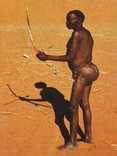
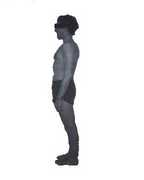
Here is an interesting article on the subject in which the author recommends barefoot walking:
Evaluations
Now it's time to evaluate your ability to engage your glutes as well as evaluating the muscles best enabling you to do so. First of all, assess your ability to activate your glutes in isolation. Lie face down on your stomach with your legs straight. Have someone either observe or actually place one hand on your hamstring and the other hand on your glute. Lift your leg up and see which muscle tenses up first.
Here is a video of the movement:
If your hamstrings fire first you might have problems. You need to re-teach the body how to fire the glutes. A simple way to do that is to actively squeeze your abs as you extend your hip.
Next, ask yourself where you get sore when you do squats? If it's primarily the glutes you're on track. If it’s ONLY the quads you may have a problem. I will discuss squatting later in this article.
Next, evaluate your pelvic tilt.
Your Pelvic Tilt:
The natural position your hips determines leverages of the muscles that control the hip. This is trainable. The hip flexors pull down on your pelvis while the lower back pulls up. The Abs pull up while the glutes pull down.
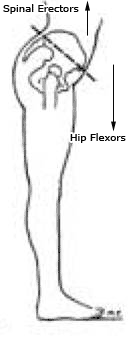
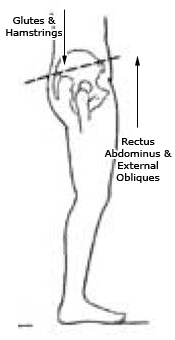
What we want to do is optimize your pelvic tilt so that your glutes are put at a leverage advantage. Ideally you want a neutral posture. The first thing we have to do is determine whether you have more of an anterior (butt sticking out), posterior (butt sucking in), or neutral posture.
Anterior pelvic tilt means that the top of the pelvis is tilted forward, and the lower back is arched. Posterior pelvic tilt means that the top of the pelvis is tipped back, and the pelvis is tucked under the body.
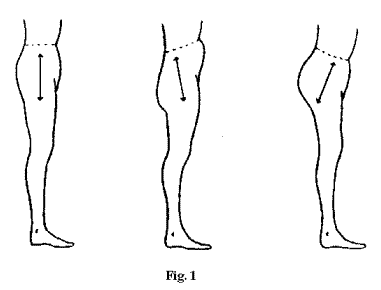
---Neutral----------------Posterior Tilt-------------Anterior Tilt
If You’re In Anterior Tilt
If you’re in anterior tilt you’ll want to loosen the muscles that pull down on your pelvis, the hip flexors, and strengthen the muscles that pull up, the abs. You'll likely only need a bit of hip flexor lengthening and some ab work. First off, here is a short video that shows you how to test for tightness of your hip flexors:
Even if you pass the test you can probably still benefit from hip flexor stretches if you have anterior tilt. Here is one:
If You’re In Posterior Tilt
In contrast, strengthening the hip flexors can be advantageous for people in posterior tilt as strengthening them will put your pelvis at a position that is more advantageous to engage your glutes. See if you have sufficient strength in your hip flexors. Place one foot up on a box so that your thigh is up above parallel. Then raise the foot up and hold it for 20 seconds without bending your support leg or squirming around.
Here is a video of Mike Boyle doing this movement:
Hip Flexor Strengthening Drill
If this test is at all difficult you could probably benefit from stronger hip flexors. To strengthen them, simply incorporate that test for a couple of sets 3 days per week. Another exercise I've found very helpful for posterior tilt is something I call a "hip suck". Lie down on your back with your legs straight and touch the area where your upper thigh inserts into the hip. Next, without bending your knee, attempt to draw the hip into the socket of the hip joint. You should feel a deep feeling in the groin. Try to relax your thigh while doing this. Hold the position for 10 secs. Repeat for 10 contractions. You can also do this standing up just make sure you don't compensate by bending your plant leg and leaning sideways.
Ab strength
Regardless of your hip posture, another KEY is to have abs that are strong enough to stabilize your spine and maintain optimal position of the hips as the hip flexors and glutes work. To assess your ab strength do the flat back leg lowering drill.
Leg Lowering Test
Lie on your back and raise your legs over your hips, with your knees slightly bent. Press the small of your back into the floor to eliminate the arch in your lower back. Try to keep your back glued to the floor as you take 3 to 5 seconds to lower your legs to the floor. Stop the test as soon as your back arches up off the ground. You should be able to get all the way to the floor. This test assesses the strength of your abs to resist the natural pull into an arched back posture. Here is a description of the test with pics and rankings:
If you test weak, perform the leg-lowering drill 3 days a week, going down as far as you can until your back begins to arch off the ground. Perform 2-3 sets of six to 10 repetitions, resting for 30 seconds between sets.
Core Stability
You'll also want to test your basic core stability.
TEST #1
PERFORM A PLANK: Get into a pushup position, then rest your forearms on the floor. Your body should form a straight line from your head to your feet (don't let your hips sag). Hold the position as long as you can. You pass if you can hold it for two minutes or longer.
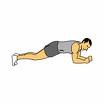
You fail if you collapse before the two-minute mark, or if your hips dip at any point within that time frame.
TEST #2
PERFORM A SIDE PLANK: Turn onto your side and, keeping your body in a straight line (just as in the plank described above), rest your weight on your forearm. Hold the position as long as you can, then repeat on the other side.
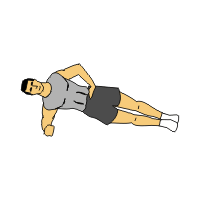
You pass if you can hold the position for 90 seconds or longer.
You fail if you collapse before the time is up, or if your hips dip at any point within that time frame.
Fortunately, if you fail at either of those tests you can remedy the problem with the same exercises you used in the tests.
For the next 3-4 weeks, perform both tests 3 times per week, doing 2-3 sets of 30-second holds for each, and working up from there.
Here are a few more exercises that will help you with the "leg lowering" aspect of ab strength. Pick one and perform 2-3 sets of 15-20 reps 3 days per week:
Quadricep Flexibility
In my experience, tight/overactive quads can also inhibit glute function and are EXTREMELY common. Additionally, if you have knee pain chances are this is one of your major issues. I recommend many of my athletes do one of the following combination quad/hip flexor stretches every day. Hold for 2 sets of 20-30 seconds:
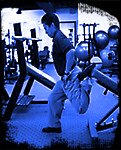
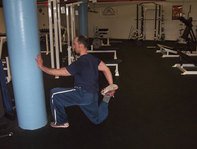
Quad dominant individuals often tend to run back on their heels, their 10 and 20 yard sprints are relatively faster than their 40's and flying 20's, they often jump better than they sprint, their bilateral jumps tend to be ahead of their unilateral jumps, and their strength tends to be ahead of their reactivity.
Note that if you are quad dominant you will probably always test quad dominant to a certain extent. A lot of this is due to genetic structural and muscular qualities. However, shifting attention to your weaknesses can balance you out and increase your performance on movements that you don't naturally do well on while continuing to push up your performance on those movements that you do.
A Word On Testing
Note also that it is possible to pass all these tests with flying colors and still have substantial imbalances. The tests will identify EXTREME weaknesses or imbalances, but often imbalances are relative. Thus, you may appear to have decent glute activation, ab strength, and hip flexor length when tested on an isolated test, but you may find that one more more aren't quite as strong as the others. If in doubt seek a qualified professional for a full evaluation.
For more info. testing and observing weaknesses and dominances check out my No Bull Speed Development Manual
Daily Glute Drills
If you feel you could benefit from more isolated glute activation and awareness, I recommend you do at least 1 of these exercises before every training session and if you REALLY have problems with glute activaton do each of them day period.
Prone Hip Extension
Cook Hip Lift
X-band or mini-band side steps
I also recommend some simple drills that helps build glute awareness. First of all, as you walk around throughout the day make a concerted effort to engage your glutes at heel strike.
You can also do some more advanced drills. Walk forward with your hands on hips for proprioception and aim to feel the glutes working. Try to walk normally and keep the rest of your lower body muscles relaxed. Next, do the same thing but this time come up on the balls of your feet and off your big toe as you stride forward,- again aiming to feel the glutes. According to Dr. Shawn Allen the foot is designed to roll to the big toe and from there the big toe gives a big push from the glute. When you tie the glutes and feet together in one movement what you're basically doing is hitting both ends of the movement efficiency/horsepower deal. You practice being light on your feet while at the same time practice engaging the muscle group that will give you the most horsepower.
Next, pick up the pace and run some buildups. After doing the prior drills, you should have an increased glute activation when you run.
Another thing you should do is pay attention to how minor changes in your posture increase the amount of glute activation you get. For example, when doing the glute activation test above, notice what happens if you squeeze your abs. You should feel your glutes kick it up a notch. Also notice what happens to your perceived gluteal recruitment with minor changes in your posture.
Exercise Selection and Sample Routines
As far as exercise selection goes, for people who tend to be more quad dominant I don't recommend regular squats at all. Low bar box squats with an emphasis on sitting back are the only types of squats I'd have them do. Always attempt to engage your glutes when you do any type of squat. From a standing position, put both hands on your hips, contract the glutes, and note the contraction. Next, leave one hand on one hip and perform a lunge with that leg. Try to contract your glute as you descend into and out of the lunge and note the contraction. Aim to replicate that contraction when you squat. Most likely you'll have to practice it to get it right. The following may also help:
A: Sit BACK into the squat and try to keep your hips back. if your knees tend to go forward it's because your quads want to take the movement over.
B: Attempt to pull yourself down into the squat by engaging your hip flexors. This goes for all other exercises as well. Engage the opposing muscle group during the eccentric. Try this with lunges, split squats, and deadlifts and you'll notice a difference.
Boris Bachmann has an excellent 2 part series on how to properly squat for posterior chain development. Check it out if you have time.
Squatting With the Glutes and Hamstrings Part I
Squatting With the Glutes and Hamstrings Part II
More Exercises
Other good exercises include Bulgarian split squats with the stance spread out wide so the knees don't go over the toes and with an emphasis on feeling the glute contraction. I also like single leg bent leg deadlifts and single leg romanian deadlifts. All deadlift variations are good, providing you do them correctly and don't round your back. Other good glute exercises include glute ham variations, Kettlebell or dumbell swings, cable pullthroughs, and Reverse Hyperextension variations.
Additionally, you can find a ton of good Kettlebell exercises targeting the glutes in Man vs weights best kettlebell exercises
On exercises like glute hams, make sure you initiate the movement by driving with your glutes.
Speed and Plyo Movements
As far as speed and plyo movements go, the following exercises will tend to be more glute dominant:
A: Top speed sprints (flying runs)
B: Lunge and split squat variations (depth drops into lunge stance, jumps out of lunge position, etc.)
C: Bounding variations
D: Single leg jumping (single leg jumps for max height, single leg jumps onto a box)
E: Sled variations
Workouts
Here is a sample 3 phase specialization workout for glute functionality. The first phase is designed to boost glute activation, awareness and strength. The 2nd phase integrates that increased awarness into compound movements for further strength. The 3rd phase is for power. Each phase should be followed for 2-4 weeks. There are 2 workouts each week. Perform them on any 2 non-consecutive days each week.
Start each workout with the above listed glute activation, ab strengthening, and either hip flexor activation, or stretching drills, and quadricep stretching drills.
Phase I
Session 1:
Toe Walks- Hands on hips - concentrate on flexing the glutes and rolling off the big toe 2 x 20 yards
Buildups- 3-4 x 20-40 yards - a natural extension of the toe walks - gradually pick up the pace from a walk to a medium paced sprint
Single leg deadlift- 2 x 10 (or max reps per side)
Single leg Romanian deadlift- 2 x 10-12 per side
Glute Ham or single leg back extension- 3 x 10-12
Session 2:
Toe Walks- 2 x 20 yards
Buildups- 3-4 x 20-40 yards
Reverse hyper or single leg back extension 2 x 12-15
Deadlift with pause- 3 x 3 (When lowering the bar, pause for 5 seconds just below knee level - be sure not to lose your arch)
Bent legged deadlift- 1 x 10
Cable pull through- 2 x 20
Phase II
Session 1:
Buildups- 4 x 60 yards (accelerate nice and smooth over 60 yards up to 90% effort)
2 hand dumbell swing- 2 x 20
Bulgarian Split Squat with pause- 4 x 5/side (pause for 5 seconds at the bottom of each rep, concentrating on flexing the glutes)
Glute Ham raise or single leg back extension- 2 x 8-12
Session 2:
Buildups- 4 x 60 yards
2 hand dumbell swing- 2 x 20
Deadlift- 1 x 3 at 100% (work up to 3 rm), 2 x 3 at 90%
Glute Ham raise or single leg back extension- 2 x 8-12
Phase III
Session 1:
3 step single leg jump for max height- Perform in sets of 1. Alternate legs. Stop at first sign of drop-off
Lunge Jumps- 3 x 4 per side (From lunge stance explode up, driving from the glutes)
Session 2:
Flying 20 yard sprints- Stop at first sign of drop-off
20 yard single leg bounds x 2 per side
